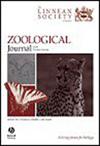Miocene marine transgression and climate variation drove diversification of subtropical Proceratophrys frogs in the Araucaria Forest
IF 2.8
2区 生物学
Q1 ZOOLOGY
引用次数: 0
Abstract
The Proceratophrys bigibbosa species group has a disjunct distribution in South America, with four out of five species inhabiting the Araucaria Forest. In this study, we investigated whether cycles of expansions/retractions of the Araucaria Forest or marine transgressions leading to the formation of the Paranean Sea may have contributed to the divergence of these frogs. It was inferred through DNA sequences from three mitochondrial and three nuclear genes across 82 individuals. Genetic divergence was assessed with haplotype networks, while demographic trends were explored using extended Bayesian skyline plots (EBSP). An environmental principal component analysis (ePCA) was also implemented to evaluate the degree of similarity of climatic spaces occupied by each species. Our phylogenetic analyses positioned P. palustris as the sister-species to P. brauni, forming a sister-clade to P. bigibbosa and an undescribed species (Proceratophrys sp.). In addition, we propose P. kaingang as a junior synonym of P. palustris. Our coalescent species tree showed divergence-time estimates ranging between 7.67 and 3.51 Mya, indicating that a marine transgression played a key role in this group diversification. Our findings highlight the combined role of Miocene marine transgressions and climatic variation as drivers of diversification in the Proceratophrys bigibbosa group.中新世海侵和气候变化推动了亚热带阿劳卡亚森林蛇尾蛙的多样化
大角蛇属(Proceratophrys bigibbosa)种群在南美洲有一个不间断的分布,5个种中有4个生活在Araucaria森林中。在这项研究中,我们调查了Araucaria森林的扩张/收缩周期或导致帕拉纳海形成的海洋海侵是否有助于这些青蛙的分化。这是通过82个个体的三个线粒体和三个核基因的DNA序列推断出来的。利用单倍型网络评估遗传差异,利用扩展贝叶斯天际线图(EBSP)探索人口统计学趋势。利用环境主成分分析(ePCA)对各物种所占气候空间的相似程度进行了评价。我们的系统发育分析将P. palustris定位为P. brauni的姐妹种,形成了P. bigibbosa的姐妹分支和一个未被描述的物种(Proceratophrys sp.)。此外,我们还认为开港木是古木的初级同义种。进化时间在7.67 ~ 3.51亿a之间,表明海侵对这一类群的进化起了关键作用。我们的发现突出了中新世海侵和气候变化的共同作用,它们是大角长鼻龙类群多样化的驱动因素。
本文章由计算机程序翻译,如有差异,请以英文原文为准。
求助全文
约1分钟内获得全文
求助全文
来源期刊
CiteScore
6.50
自引率
10.70%
发文量
116
审稿时长
6-12 weeks
期刊介绍:
The Zoological Journal of the Linnean Society publishes papers on systematic and evolutionary zoology and comparative, functional and other studies where relevant to these areas. Studies of extinct as well as living animals are included. Reviews are also published; these may be invited by the Editorial Board, but uninvited reviews may also be considered. The Zoological Journal also has a wide circulation amongst zoologists and although narrowly specialized papers are not excluded, potential authors should bear that readership in mind.

 求助内容:
求助内容: 应助结果提醒方式:
应助结果提醒方式:


